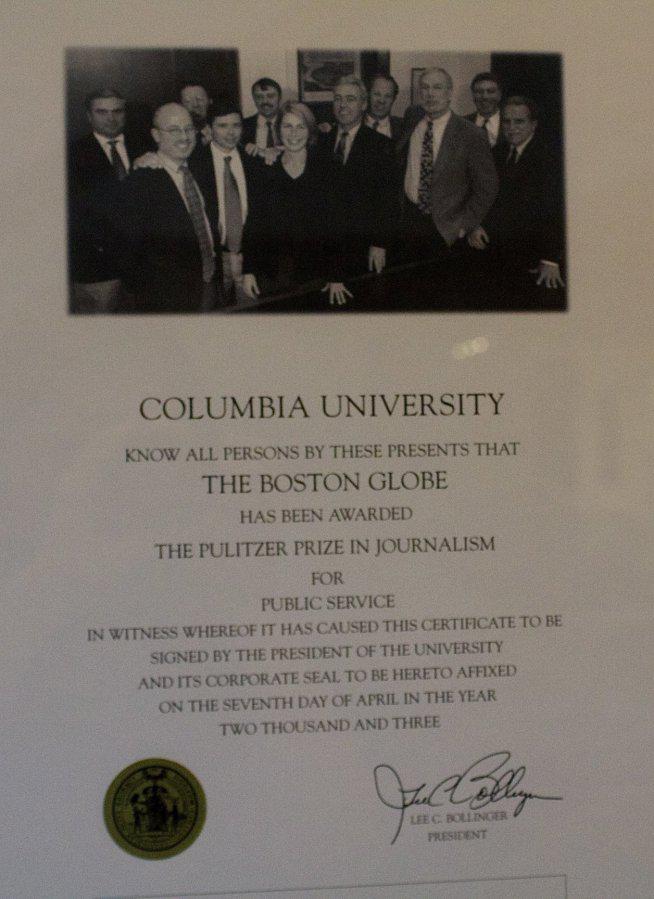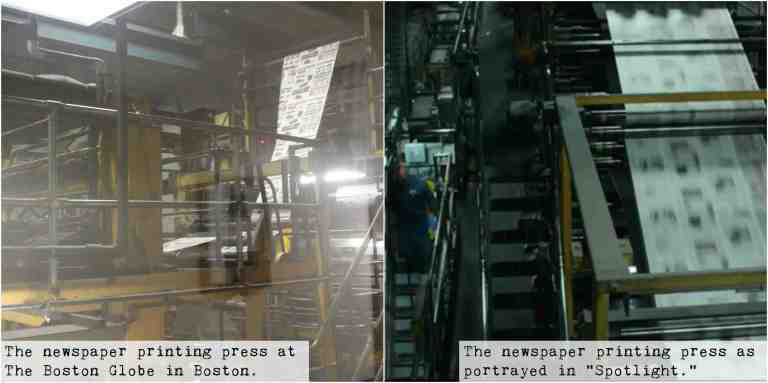|
EXCLUSIVE: Q&A with The Boston Globe investigative reporter Walter Robinson
By Chloe Jepsen
The movie “Spotlight,” which was directed by Tom McCarthy, won the Academy Award for Best Picture this past year. It follows “The Boston Globe’s investigative journalism team,” as it investigated and reported on widespread sexual abuse in the Catholic Church. The team, known as “Spotlight,” was led by editor Walter Robinson and included reporters Michael Rezendes, Matt Carroll and Sacha Pfeiffer, who were played by Michael Keaton, Mark Ruffalo, Brian d’Arcy James and Rachel McAdams, respectively. The Sagamore conducted a Q&A with Robinson about the original investigation and his thoughts on the movie interpretation of it: Q: How close was the Spotlight movie to what you actually did? A: It was very close. It’s not a documentary, and, obviously, it’s not a transcript. It’s a dramatization. Here’s the best way I can explain it: you and I are having a conversation right now, and if we weren’t taping it, but it was an important conversation, and somebody came to us and said ‘I’m doing a movie and one of the scenes is going to be that conversation,’ you would tell the person what transpired. It might be thirty seconds of your recollection, and then the person would call me and say, ‘Tell me what happened when you two talked,’ and I would recall what happened. Then, the person writing the movie would go off and write a scene. None of the words coming out of the mouth of the actor playing you or the actor playing me would be what we actually said because even we don’t remember the exact words. But the question is would it faithfully capture what actually happened? The film very accurately captured what happened in real life. We were afraid that Hollywood would sensationalize what we did. In fact, they did not. The director Tom McCarthy and the screenwriter Josh Singer, who co-wrote the screenplay, spent weeks in Boston interviewing each of us for days on end. They tape recorded all the interviews, and they interviewed many other people who are portrayed in the film. We also gave them all of the contemporaneous emails from that period of time so they could reconstruct what happened when, which was pretty important because this was ten years before they started making the film. We gave them lots of documents. They put an enormous amount of research into this, so they were in effect investigating our investigation. They spent so much time on it, and we were really happy because it indicated to us that they really wanted to tell the story the way it happened. Q: Do you think that Hollywood took any liberties at all in the makings of Spotlight? A: One thing they did was create scenes in the film that actually didn’t happen but were needed to carry the narrative along. There are some composite characters. For instance, there’s one lawyer in the film named Jim Sullivan, and that’s actually a composite of about six different lawyers. If they tried to have my character in the film, Michael Keaton, talking to and interviewing six different lawyers, it would have made for a three hour movie. So they basically condensed six characters into one. The same is true of this other character Pete Connelly, who plays the Cardinals’ confidant. He was basically a composite of three or four people. They had to take five months of our work and distill it down to two hours and eight minutes. That’s pretty hard to do. They left out a lot of reporting steps we took. They just couldn’t do it in a film. There is one scene where Mark Ruffalo has a blowup with me, Michael Keaton. He wanted to put the story in the paper, and they got into a shouting match, saying, ‘It could have been you. It could have been me. It could have been anyone. We have to nail these bastards!’ I basically told him to shut up. That actually happened, and the real Mike Rezendes has a little bit of a temper. The decibel level in that exchange in real life was probably lower, but it still took place. They showed us the screenplay, the final draft, and we made a lot of suggestions, and some of them they took. An example of this would be the wording: ‘Well, a reporter really wouldn’t say it that way, they’d say it this way.’ That kind of stuff. We had given them the right to say whatever they wanted, but we still had the right to say, ‘Geez, we would rather if you did it this way.’ They took our suggestions. On set in Toronto, where they were filming the movie, there were different kind of questions that the actors would ask us, like ‘What would a reporter do with a notebook? When would you take a notebook out during an interview?’ The answer is: well, it depends on who you’re interviewing. There were a lot of little journalistic questions we answered. Q: What was it like to be one of the main characters in the movie? A: It’s kind of weird to be thrust out in the public like this. We are used to asking questions, and here I am answering questions. But, I’ve spent much of the last two years answering questions from reporters. Actually, I’m better at it now than I was two years ago. It’s been kind of surreal for us to get this much attention. Some people treat us like celebrities, and that’s kind of weird. But you know, I still go to the supermarket, and nobody knows who the hell I am. Q: What was your personal favorite scene in the movie and why? A: Mine would probably be the scene where we were sitting around the desk having a conference call with Richard Sipe, and he informs us that there could be as many as 90 priests. We’re thinking that there are 13 priests. The camera work is amazing. The camera is pulling away, and when they realize It’s 90, there’s silence. Richard Syke is like, ‘Hello?’ They were all stunned. That was kind of the turning point in our investigation. Then, we had to figure out: ‘How do we prove that?’ That’s how we got into these directories. That whole section of the movie was probably my favorite. The scene that I thought was very weak when I read the script was at the end , where they come in on Sunday and the phones are ringing off the hook. I thought that was a really weak way to end the movie. Then, when I saw it in the film, I think a lot of people were kind of blown away. I think that’s a tribute to the filmmaker because we see it as words on paper, but he can envision it how the actors would play it. The director Tom McCarthy, is brilliant. Hot off the press! On the left, the newspaper printing press for The Boston Globe, located in the city, is pictured. On the right, an aerial of the “Spotlight” printing press is pictured. Q: Do you think that winning an Oscar has helped bring more awareness to sexual abuse in the church? A: I think we have been kind of astonished at how much impact a film can have on the public consciousness. When something like that gets into popular culture, it can have even a great deal more impact than the original published stories did. The fact that even the Vatican has praised the film is pretty amazing. I think it has had the effect of putting a fair amount of pressure on the Church to make the kind of reforms that they have been kind of dragging their heels on since 2002. It was a pretty high impact film. Q: Do you think that the movie compelled people to become investigative journalists or journalists in general? A: Well, I hope so. I have spent a lot of time in the last couple of months on college campuses talking to people about the film. It has really generated a lot of interest and enthusiasm, at least among students. Some people who see it are thinking, ‘What can I do with my life that might make a difference?’ You see a film like this and, even though journalism isn’t going to get you into the top one percent of people with money, it can be an extraordinarily rewarding career where you really can make a difference in people’s lives in lots of different ways and with lots of different stories. You don’t have to do a story like this one, which obviously had much more impact. But, there are lots of other stories that can really make a difference in people’s lives. So, I’m hoping that when people see the film, particularly young people who are looking for some way to have a really fun career that is rewarding, they would think about journalism.
Q: Do you have any advice for young writers and aspiring journalists?
|
.
Any original material on these pages is copyright © BishopAccountability.org 2004. Reproduce freely with attribution.

